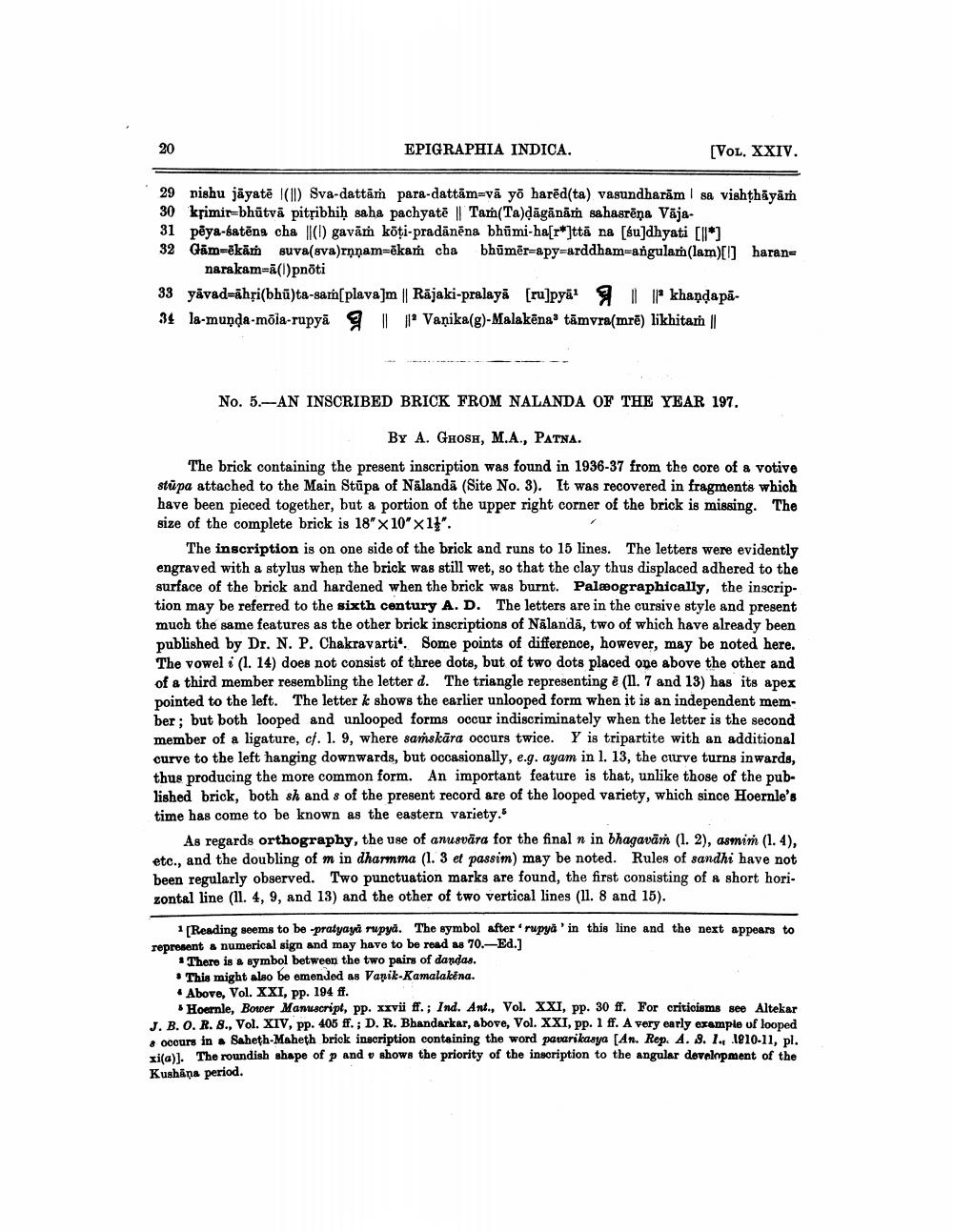________________
EPIGRAPHIA INDICA.
(VOL. XXIV.
29 nishu jāyatë 1(1) Sva-dattām para-dattām=vā yo harëd(ta) vasundharām sa vishthayam 30 krimir-bhūtvā pitsibhiḥ saha pachyatē || Tam(Ta)dāgānām sahasrēna Väja31 pēya-batēna cha (1) gavām köti-pradānēna bhūmi-ha[r*]ttā na [śuldhyati II* 32 Gām=ēkām suva(sva)rņņam=ēkam cha bhūmēr=apy=arddham=angulam(lam)[] haran=
narakam=ā(i)pnoti 33 yāvad=āhți(bhū)ta-sam(plava]m || Rājaki-pralaya [ru]pyä!
khaņdapā. 34 la-munda-mõla-rupyā || | Vaņika(g)-Malakēnas tāmvra(mrē) likhitam ||
No. 5.-AN INSCRIBED BRICK FROM NALANDA OF THE YEAR 197.
By A. GHOSH, M.A., PATNA.
The brick containing the present inscription was found in 1936-37 from the core of a votive stūpa attached to the Main Stūpa of Nālandā (Site No. 3). It was recovered in fragments which have been pieced together, but a portion of the upper right corner of the brick is missing. The size of the complete brick is 18" x 10" x 11".
The inscription is on one side of the brick and runs to 15 lines. The letters were evidently engraved with a stylus when the brick was still wet, so that the clay thus displaced adhered to the surface of the brick and hardened when the brick was burnt. Palæographically, the inscription may be referred to the sixth century A. D. The letters are in the cursive style and present much the same features as the other brick inscriptions of Nālandā, two of which have already been published by Dr. N. P. Chakravarti. Some points of difference, however, may be noted here. The vowel i (1. 14) does not consist of three dots, but of two dots placed one above the other and of a third member resembling the letter d. The triangle representing < (11. 7 and 13) has its apex pointed to the left. The letter k shows the earlier unlooped form when it is an independent member: but both looped and unlooped forms occur indiscriminately when the letter is the second member of a ligature, cf. 1. 9, where sařskāra occurs twice. Y is tripartite with an additional curve to the left hanging downwards, but occasionally, e.g. ayam in l. 13, the curve turns inwards, thus producing the more common form. An important feature is that, unlike those of the published brick, both sh and 8 of the present record are of the looped variety, which since Hoernle's time has come to be known as the eastern variety.
As regards orthography, the use of anusvāra for the final n in bhagavāṁ (1.2), asmin (1.4), etc., and the doubling of m in dharmma (1. 3 et passim) may be noted. Rules of sandhi have not been regularly observed. Two punctuation marks are found, the first consisting of a short hori. zontal line (11. 4, 9, and 13) and the other of two vertical lines (11. 8 and 15).
1 [Reading seems to be -pratyaya rupya. The symbol after "rupya ' in this line and the next appears to represent a numerical sign and may have to be read as 70.-Ed.]
* There is a symbol between the two pairs of dandas. • This might also be emended as Vapik-Kamalakēna. . Above, Vol. XXI, pp. 194 ff.
Hoernle, Bower Manuscript, pp. xxvii ff. ; Ind. Ant., Vol. XXI, pp. 30 ff. For criticisms see Altekar J. B.O.R. 8., Vol. XIV, pp. 405 ff.; D. R. Bhandarkar, above, Vol. XXI, pp. 1 ff. A very early example of looped
occurs in . Sabeth Maheth brick inscription containing the word pawarikasya (An. Rep. A. 9. 1., 1910-11, pl. xia)]. The roundish shape of p and v shows the priority of the inscription to the angular development of the Kushāna period.




